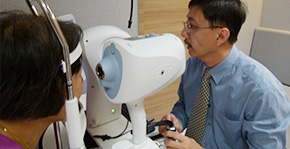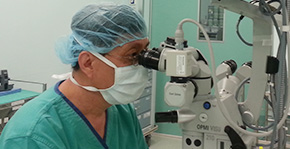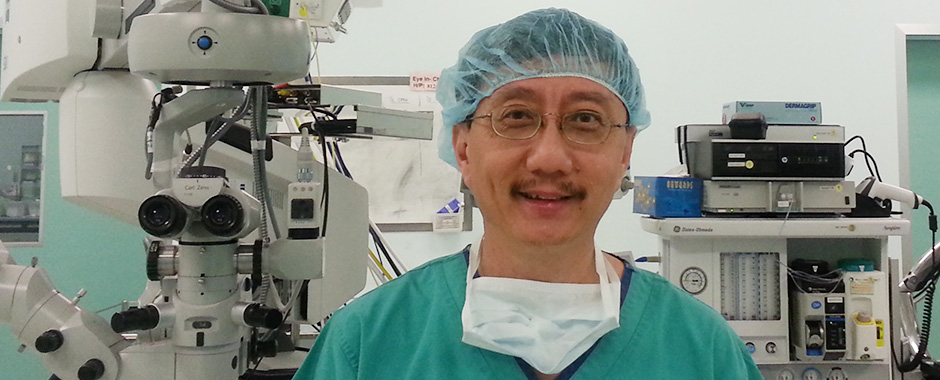



Specialised Care:
- Cataract Surgery/ 白内障手术
- Laser Treatment/ 激光治疗
- Sudden Vision Loss/ 视力突然丧失
- Vision Rehabilitation/ 视力恢复矫治
- Neuro-Ophthalmology/神经眼科学
- Myopia Management for Children/儿童恢复矫治
- Dry Eyes/干眼症
- Red Eyes/红眼症
- Eye Injury/眼外伤
Eye Screening:
- Myopia in Children/儿童恢复矫治
- Macular Degeneration/ 黄斑变性
- Diabetic Eye/糖尿病
- Glaucoma/青光眼
Our Services
Cataract Surgery

Normal lens
Dense white cataract causing blindness
What is cataract?
Cataract is a common condition among the elderly where the normal clear lens in the eye becomes cloudy or nearly opaque.
Symptoms of cataract:
1. Blurring of vision
2. Double vision
3. Glare from headlamps
4. Rapid change in spectacle degrees
Treatment:
1. Change of glasses (if cataract is very early and not causing much visual disturbance)
2. Removal of the cataract using phaco-emulsification surgery (ultrasound energy to break up the cataract into small fragments to allow them to be removed through a small 2.2 mm incision.
3. The recent use of femto-second laser assisted cataract surgery (bladeless surgery) is available at Mt Elizabeth using the advanced Alcon LenSx laser system.
4. The cataractous lens are replaced with one of the following types of intra-ocular lens (IOL):
Monofocal IOL : This type of lens is suitable for patients without astigmatism. It gives relatively good vision for distant objects. However, reading glasses are required for prolonged near-work.
Toric IOL : This type of lens is suitable for patients with astigmatism as it significantly corrects their astigmatism. It gives relatively good vision for distant objects but reading glasses are required for prolonged near-work.
Multifocal IOL : This type of lens allows patients to be spectacle-free for both near-work and distant vision.
A cataract surgery gives very good outcomes in most cases unless the cataract is very dense or the patient has underlying undetected eye conditions. The most common mode of surgery is by phaco-emulsification, termed the “gold standard”. (The Straits Times, 16 May 2013). To date, A/Prof Goh has performed more than 3000 cataract surgery in his thirty years of experience as a highly-skilled eye surgeon.

Removing a cataract by
phaco-emulsification
Inserting a lens into the eye
after cataract surgery
Sudden Vision Loss
Sudden vision loss is usually attributable to ischemia, or a reduction of the amount of oxygen and nutrients to the tissues of the eyes, resulting in temporary or permanent damage to the retina. It is like a stroke of the eye. Ischemia has several causes and can appear in different forms. It may indicate uncontrolled or high blood pressure. A treatable condition that may save your vision and may abort a stroke.
Vision Rehabilitation
 Vision Rehailitation aims to maximise a patient’s residual visual ability to enable him to perform activities independently for daily living. It involves the use of optical aids / devices and software programmes to enhance his vision.
Vision Rehailitation aims to maximise a patient’s residual visual ability to enable him to perform activities independently for daily living. It involves the use of optical aids / devices and software programmes to enhance his vision.
Mr Ang said: “I’ve got almost 90 per cent of my eyesight back. I can see better and, of course, I feel happier.” The Straits Times, 10 June 2006
Help for patients with impaired vision
 Many diseases of the eye and the brain cause visual deficits that can be improved through rehabilitation. The consultation involves a detailed assessment and tests of the patient’s eye components before a specially-tailored rehabilitation programme is drawn up to maximize his residual function.
Many diseases of the eye and the brain cause visual deficits that can be improved through rehabilitation. The consultation involves a detailed assessment and tests of the patient’s eye components before a specially-tailored rehabilitation programme is drawn up to maximize his residual function.
Myopia Management for Children
 Children often have a progressive form of near-sightedness, or myopia that worsens throughout childhood. Their vision, though, is easily corrected with eyeglasses, and it usually stabilizes in their 20s when their eyes are no longer growing.
Children often have a progressive form of near-sightedness, or myopia that worsens throughout childhood. Their vision, though, is easily corrected with eyeglasses, and it usually stabilizes in their 20s when their eyes are no longer growing.
Dry Eyes / Red Eyes / Eye Injury
Dry eyes is an eye condition caused by a problem with tears. Dry eyes can make your eyes feel dry, scratchy, irritated or uncomfortable. It often affects both eyes but sometimes one eye is affected more than the other. It can make you feel as though there is something in the eye, like an eyelash or a piece of grit, even when there is nothing there. Dry eyes can make your vision slightly blurry, though usually only for short periods of time. The blurriness usually gets better on its own or when you blink.
Red eyes appear red because the vessels in the surface of the white portion of the eye (sclera) are swollen. This can result from dry air, excessive sunlight, dusty environments, allergies, infection, injuries or foreign bodies in the eye. Some common eye injuries, such as deep puncture wounds from accidents, may require immediate treatment or surgery to prevent permanent eye damage resulting in vision loss.
Neuro-ophthalmlogy
Neuro-ophthalmology is a highly- specialized branch of ophthalmology which deals with diseases of the nervous system affecting the eye. A/Prof Goh’s vast experience in this field makes him a leading figure in managing patients with optic nerve disorders, double vision (diplopia), eye movement disorders and strokes. Using advanced equipment like the Optical Coherence Tomography, he is able to assess the retinal nerve fibre layer to form an early diagnosis. This early intervention always results in a better outcome before the condition becomes irreversible. In some cases, patients may be co-managed with a neurologist or neuro-surgeon.

Neuro-ophthalmic Assessment
and Treatment
Optic nerve disorder
Screening Packages
Children
 At Dr Goh Eye, we screen children from as young as 4 years old for myopia, amblyopia and squints.
At Dr Goh Eye, we screen children from as young as 4 years old for myopia, amblyopia and squints.
Myopia is a condition whereby the normal eyeball becomes elongated and as a result a blurred image is formed on the retina. This condition is becoming more common among children and students in highly urbanized countries like Singapore. Myopia can be controlled via atropine eye drops (The Straits Times 18 July 2013)
Amblyopia or lazy eyes can be caused by not wearing corrective spectacles from young or from undetected squints.
Squints occur when both eyes are not correctly aligned. When uncorrected, it can cause Amblyopia.
Adults
 Screening for adults include an assessment of the vision and the retina. Many middle-aged adults suffer from diabetes, hypertension and hyperlipidaemia and these diseases affect the blood vessels in their body, including their vision.
“The eye is the window to one’s soul” and an eye examination is highly valued for its non-invasive nature to detect the health of these fine blood vessels. This provides great insight to the doctor for the proper management of a patient’s underlying ailments.
Screening for adults include an assessment of the vision and the retina. Many middle-aged adults suffer from diabetes, hypertension and hyperlipidaemia and these diseases affect the blood vessels in their body, including their vision.
“The eye is the window to one’s soul” and an eye examination is highly valued for its non-invasive nature to detect the health of these fine blood vessels. This provides great insight to the doctor for the proper management of a patient’s underlying ailments.
The Elderly
 Many of our elderly have underlying eye conditions like cataracts, glaucoma and age-related macular degeneration.
Many of our elderly have underlying eye conditions like cataracts, glaucoma and age-related macular degeneration.
Cataract is a condition where the normal clear lens in the eye becomes cloudy or nearly opaque, thus affecting one’s vision and quality of life.
In glaucoma, the eyeball pressure rises insidiously, causing silent and progressive damage to the optic nerve, eventually leading to blindness.
Age-related macular degeneration destroys the macular (central part of the retina) leading to loss of the central vision.
At Dr Goh Eye, screening of the elderly is targeted at detecting these conditions. Tests like intra-ocular pressure measurement and the Amsler grid assessment are administered. Photographs of the retina and optic discs are taken for a detailed analysis. In borderline cases of glaucoma and age-related macular degeneration, an optical coherence tomography and the use of a ganglion cell complex software will help in an early diagnosis for a better outcome.

